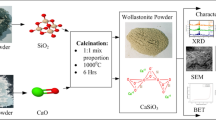Abstract
JNARDDC has evaluated bauxite deposits of India from the geo-technological point of view. During the evaluation studies, it was observed that bauxite deposits are associated with saprolite resources. During bauxite mining, various low-grade materials such as saprolite, laterite and low-grade bauxite are generated. These materials typically have low-alumina, high-iron oxide and high-silica content. Owing to their inferior quality, these materials cannot be used for alumina production and hence remain unutilized at the mine site. For the present study, the saprolite samples were collected from the Western Ghats bauxite deposits in India. The sintering studies were conducted on saprolite granules using a variety of parameters. The sintered granules were characterized, and their properties determined. The test results showed that bulk density, apparent density, porosity and refractoriness (PCE 1645–1659 °C) of the aggregates were within the range of refractory specifications. The feasibility tests carried out at the refractory industry indicated that the developed aggregates are suitable as refractory material and can substitute for calcined clay. Currently, high-purity clay resources used in the refractory industry are limited and fast exhausting; therefore, the industry is likely to face an acute shortage of raw materials, which will become more critical in the future. Therefore the sintered granules (aggregates) developed from saprolite, which is a mining waste, provide a low-cost, eco-friendly solution for the fast-exhausting resources of the high-purity clays. The developed process may change the Indian bauxite mining scenario because saprolite may substitute as a potential raw material for the refractory industry.





Similar content being viewed by others
Abbreviations
- AD:
-
Apparent density
- BD:
-
Bulk density
- JNARDDC:
-
Jawaharlal Nehru Aluminium Research Development and Design Centre
- PCE:
-
Pyrometric cone equivalent
- PLC:
-
Permanent linear change
- SEM:
-
Scanning electron microscope
References
Bhukte PG, Daware GT, Masurkar SP, Mahendiran P, Janbandhu K, Rao KR, Singh U, Puttewar SP, Agnihotri A (2020) Geochemical, mineralogical and petrological characteristics of lateritic bauxite deposits formed on Deccan trap basalt with reference to high-level and coastal (low level) deposits of Maharashtra. J Geol Soc India 95:587–598
Bhukte P, Daware G, Puttewar SP, Nimje MT, Gijare A, Janbandhu K, Agnihotri A (2017) A process for development of refractory aggregates from saprolite; 21st International Conference on Non-Ferrous Minerals and Metals -2017, Hotel Shangri-la Eros, New Delhi, 7–8 July 2017, pp 54–59
Bhukte PG, Chaddha MJ (2014) Geotechnical evaluation of eastern Ghats bauxite deposits of India. J Geol Soc India 84:227–238
Pravin B, Puttewar SP, Daware G, Agnihotri A, Thakre GP (2017) Status of lateritic bauxite deposits of India for non-metallurgical applications. J Indian Geol Congr 9:71–79
Momade FWY, Gawu SKY (2009) Geochemical and mineralogical characteristics of lithomargic clay types from Awaso bauxite deposit, Ghana. Implications for possible industrial utilization. J Sci Technol 29:96–106
Bhukte PG, Puttewar SP, Agnihotri A (2017) Evaluation and beneficiation of lateritic bauxite deposits of India. J Geosci Res 1:251–256
Perepelitsyn VA, Yagovtsev AV, Merzlyakov VN, Kochetkov VV, Ponomarenko A, Ponomarenko ZG, Kolobov AY (2019) Prospective technogenic mineral resources for refractory production. Refract Ind Ceram 60:12–16
Raja BV (2006) Status & Outlook of Indian refractory industry. Steel World Focus 2006:9–13
Muhammadu MM (2013) An investigation on refractory clays properties for application in metallurgical Industries in Nigeria. Int J Adv Res 6:200–207
mathew GO, Seun Samuel OWOEYE (2016) Characterization of Abaji clay deposits for refractory applications. Leonardo Electron J Pract Technol Issue 29:115–126
Frulli D (2016) Production and properties of refractory raw materials based on Andalusite and Mullite influence of impurities in the refractory behaviour, Refractory world forum. Imerys Refract Miner France Technol News 8:1–4
Sadik C, El Amrani I-E, Albizane A (2014) Recent advances in silica-alumina refractory. A review. J Asian Ceram Soc 2:83–96
Satyendra (2015) Refractory Castables. Ispat Digest. https://www.ispatguru.com/refractory-castables/
Raghavan P (2002) Beneficiation and value addition of China clay. Int Semin Miner Process Technol 2:537–543
Kłosek-Wawrzyna E, Małolepszy J, Murzyn P (2013) Sintering behaviour of kaolin with calcite. Procedia Eng 57:572–582
Fatai Olufemi ARAMIDE (2015) Effects of sintering temperature on the phase developments and mechanical properties ifon clay. Leonardo J Sci 26:67–82
Myhre B, Hundere AM, Feldborg H, Odegard C (1999) Correlation between mullite formation and mechanical properties of refractory castables at elevated temperatures. Elkem Materials Norway, pp 1–6. https://www.yumpu.com/en/document/read/50818419/correlation-between-mullite-formation-and-mechanical-elkem
Nigay P-M, Cutard T, Nzihou A (2017) The impact of heat treatment on the microstructure of a clay ceramic and its thermal and mechanical properties. Ceram Int Elsevier 43:1747–1754
Yahya H, Othman MR, Ahmad ZA (2016) Effect of mullite formation on properties of aluminosilicates ceramic balls. Procedia Chem J 19:922–928
Viswabaskaran V, Gnanam FD, Balasubramanian M (2002) Mullitization behaviour of south Indian clays. Ceram Int J 28:557–564
Johari S, Said B, Hisham A, Bakar Z, Ahmad A (2010) Effect of the change of firing temperature on microstructure and physical properties of clay bricks from Beruas Malaysia. Sci Sinter 42:245–254
Andrewsa A, Adama J, Gawu SKY (2013) Development of fireclay aluminosilicate refractory from lithomargic clay deposits. Ceram Int 39:779–783
Mustafi S, Ahsan M, Firoz SH (2004) Investigation on various composition of refractory Castable. Bangladesh J Sci Indus Res 39:107–114
Acknowledgements
The authors are grateful to Dr. Anupam Agnihotri, Director, JNARDDC for granting permission to publish this paper. Thanks are due to the staff of JNARDDC for carrying out the laboratory work.
Funding
The authors respectfully acknowledge the Science and Technology Wing, Ministry of Mines, Government of India for sponsoring and financial support of the research projects.
Author information
Authors and Affiliations
Corresponding author
Ethics declarations
Conflict of Interest
The authors declare that they have no conflict of interest.
Additional information
Publisher’s Note
Springer Nature remains neutral with regard to jurisdictional claims in published maps and institutional affiliations.
Rights and permissions
About this article
Cite this article
Bhukte, P.G., Daware, G.T., Masurkar, S.P. et al. Converting Saprolite (a Low-Grade Unutilized Material) into Refractory Aggregates: A Viable Substitute for Calcined Clay in the Refractory Industry. Mining, Metallurgy & Exploration 38, 1589–1595 (2021). https://doi.org/10.1007/s42461-021-00407-w
Received:
Accepted:
Published:
Issue Date:
DOI: https://doi.org/10.1007/s42461-021-00407-w




